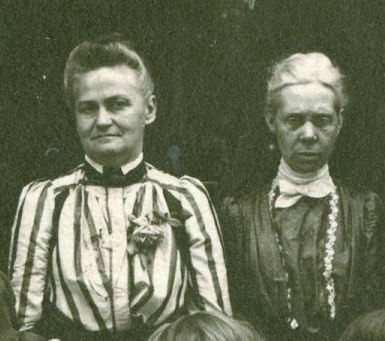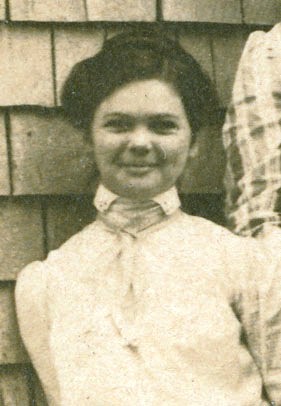 Rollins students and faculty, 1901-02
Rollins students and faculty, 1901-02
One of the most-noticed items on display in the Archives is this photo of the Rollins community in the early 1900s. It was taken at Knowles Hall, the first building on campus and a popular site for group pictures.
Using digital technology, researchers can study an old photograph like this one in a whole new way. A high-resolution scan makes it possible to adjust the color and contrast, and to zoom in on details, making faces from the past visible once more.
As the enlarged image below shows, turn-of-the-century dress at Rollins was rather formal. Ties, coats, and hats were worn by male students, even at picnics or when boating on the lake. Most of the young women are wearing shirtwaists (blouses) and the bouffant hairstyle associated with the “Gibson Girl” look of the period.

Of the 106 people in the photo, we have the names of 42. None of the young men seated in the front have been identified. Their very youthful appearance suggests that they were members of the College’s preparatory division, which offered the equivalent of a high school curriculum. (Since educational institutions were rare in Florida at that time, relatively few students were ready to study at the college level. Many of the earliest Rollins students were enrolled in what was known as the Academy.)
Just behind the boys, on the left, is E. Grace Boone ’07 (1884-1960), who went on to become a teacher. Her father, Cassius, was one of the incorporators of the city of Orlando in 1875, and had served as its mayor. A descendant of the famous frontiersman Daniel Boone, he also taught the first public school in Orange County and ran a hardware store, among other accomplishments (it seems that pioneers such as Mr. Boone often wore many hats).
In 1958 Grace Boone reminisced about Rollins and her favorite teachers, all of whom appear in this photo. She recalled President George Morgan Ward’s “wisdom, his kindness, his readiness to give help to a floundering youngster confronted for the first time with a college catalogue and the need of choosing a course of study.” She wrote of one memorable occasion when students welcomed him back to Rollins: “The college boys got a carriage from the local livery stable, harnessed themselves to the shafts and conveyed Dr. and Mrs. Ward to their home on the campus.”
She also affectionately remembered Dr. Thomas Baker, “whose wit and humor made him the idol of the campus, and who could teach Physics, Chemistry and Botany without recourse to a text-book.” Prof. Susan Longwell, who reminded Miss Boone of Dame Edith Sitwell, “made literature come alive” and “left a lasting imprint on all our lives.” And Prof. Lord’s mastery of Latin made it seem that it “must be her native tongue.” Miss Boone also emphasized the high standards her professors maintained for their students: “I may say here that all three of these teachers were what students nowadays sadly shake their heads [at] and call ‘perfectionists.'”
Below: Pres. Ward (with dark mustache). Prof. Longwell stands to the left of the President (behind his shoulder). Below them is Dr. Thomas Baker (with white beard).
Below: Caroline Abbott, the director of the Preparatory Division (on the left) and Prof. Frances E. Lord
The College’s yearbook, the Tomokan, began publication in 1917, so most of the earliest Rollins students and faculty appear only in group photos such as this one. How wonderful to be able to see them today as individuals and a part of the Rollins community.
More information about President George Morgan Ward and Dr. Thomas Baker can be found at the Archives’ Golden Personlities site: http://asp3.rollins.edu/olin/oldsite/archives/golden/index.html . Photos of Knowles Hall (destroyed by a fire in 1909) can be found in the Digital Archives (http://www.rollins.edu/library/archives/digitalarchives.html ).
~ by D. Moore, Archival Specialist


Darla — I can’t identify any of these people but the ones that I am really curious about are the two women behind and to the left of Pres. Ward. Are those Profs. Lord and Longwell? More importantly, why are they so sad? Are they bored of standing still for the long exposure, or is something else going on?
Jonathan,
After reading your comment, I revised my post. The woman to the left of Prof. Longwell is Nathalie Lord, Secretary of the Faculty. Her sister, Frances E. Lord, was a Latin professor at Rollins.
It may be that they look sad because of the long exposure time required for early photographs, which made it hard to hold a smile. Experts have also suggested that photos used to be meant for posterity and considered to have a serious purpose. A discussion of this can be found at http://wesclark.com/jw/imponderables.html .
On the other hand, the descriptions we have from their students suggest that these particular teachers were quite somber-looking in their everyday lives. One student wrote of Prof. Lord, “I stood in fear and awe of her, she was so severe and exacting.” Even her way of dressing was unusually somber (“she often wore rubbers [and], dressed in things so inconspicuous that I have no idea what they were like”). It was reported that the Misses Lord, who lived together on Interlachen Avenue, even spoke Latin when at home.
Susan Longwell, described as “tall, ramrod straight [and] concise in her speech” was remembered as someone whose appearance could be deceiving. “You had to know her well to discover her delicious sense of humor, her deep humanity, the warm woman. . . I grew to love her dearly. She brought English literature alive for her students. . .”
Both of these women were remembered as very accomplished, dedicated teachers. They each studied at Oxford and taught at prestigious institutions before coming to Rollins (Frances Lord taught at Wellesley College, where she had served as Acting President, and Susan Longwell had been a professor at Smith College). In 1928, Martha “Patty” Howes Christiancy ’07, a classmate of Grace Boone, wrote of the high regard she and her classmates had for the entire Rollins faculty:
“. . .the aim of the founders of Rollins, and of every teacher within her gates, in my day, was expressed in the motto on the seal, “Let there be Light”. . . To understand and appreciate the light that Rollins shed twenty-five years ago, you must go back with me in imagination to the Florida of that day, and think of her half-dozen or less high schools, and poorly equipped grade schools. At twelve I could have gotten a teacher’s certificate. . . Mention is made of this, only to show you how scanty the requirements for teachers were, then, and to bring home to you more forcibly what it meant to any ambitious student. . . to have within a day’s journey even a small college like Rollins whose professors came to her. . .from years of teaching in Yale, Harvard, Oberlin, Toronto University, Wellesley, Vassar, Smith, Massachusetts Conservatory of Music and like institutions. Do you wonder that we of the old guard love her for what she meant to us when we all were young?”
~ Darla
Absolutely fascinating! And what informing comments about the quality and character of the early faculty at this small, struggling college.
The detail of the enlarged images is stunning — another gift of technology. But it is your research, linking faces and names, and then adding their commentary, which makes this SO interesting. Thank you!
I treasure the 1941 “family portrait” with Hamilton Holt and the 1985 panoramic photo at the Centennial. Now I will add this 1901-02 photo, as well.
My grandmother Martha Prince Howes ( Christiancy) I have been told was a graduate of Rollins College around 1907. I see a reference to a message written by Patty Howes Christiancy, who would be mother, born in 1917. I wonder if the statement could have been made by Martha not Patty? I do not recognize my grandmother in the photos on this web page. Grandmother was born around 1884 in Oak Hill, Florida. Thank you.
I found a newspaper article (newspapers.com) in the Ocala Banner Feb 3 1905 written by Thomas R. Baker of Rollins College. It was recount of old Florida freezes including the rare 18th century accounts. I used this article in my booklet – Famous Freezes in Central Florida. The newspaper article provided a nice group or temp readings from Jacksonville dating back in time. Otherwise, it was the typical – well known – freezes of 1894/95, 1899 etc. However, he did have a nice comparison of the cold temps/snow in 1905.